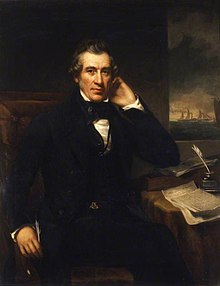William Fairbairn
| William Fairbairn | |
|---|---|

by Benjamin Rawlinson Faulkner, in the foreground Observations of the Cold blast, referring to On the strength and properties of cast iron obtained from the Hot and Cold blast, presented at the British Association for the Advancement of Science in 1838
|
|
| Born |
19 February 1789 Kelso |
| Died | 18 August 1874 (aged 85) Moor Park, Farnham |
| Nationality | British |
| Known for | Structural ironwork Shipbuilding Locomotives Lancashire Boiler |
Sir William Fairbairn, 1st Baronet of Ardwick (19 February 1789 – 18 August 1874) was a Scottish civil engineer, structural engineer and shipbuilder.
Born in Kelso to a local farmer, Fairbairn showed an early mechanical aptitude and served as an apprentice millwright in Newcastle upon Tyne where he befriended the young George Stephenson. He moved to Manchester in 1813 to work for Adam Parkinson and Thomas Hewes. In 1817, he launched his mill-machinery business with James Lillie as Fairbairn and Lillie Engine Makers.
Fairbairn was a lifelong learner and joined the Institution of Civil Engineers in 1830. In the 1820s and 30s, he and Eaton Hodgkinson conducted a search for an optimal cross section for iron beams. They designed, for example, the bridge over Water Street for the Liverpool and Manchester Railway, which opened in 1830. In the 1840s, when Robert Stephenson, the son of his youthful friend George, was trying to develop a way of crossing the Menai Strait, he retained both Fairbairn and Hodgkinson as consultants. It was Fairbairn who conceived the idea of a rectangular tube or box girder to bridge the large gap between Anglesey and North Wales. He conducted many tests on prototypes in his Millwall shipyard and at the site of the bridge, showing how such a tube should be constructed. The design was first used in a shorter span at Conway, and followed by the much larger Britannia Bridge. The tube bridge ultimately proved far too costly a concept for widespread use owing to the sheer mass and cost of wrought iron needed. Fairbairn himself developed wrought iron trough bridges which used some of the ideas he had developed in the tubular bridge.
...
Wikipedia
